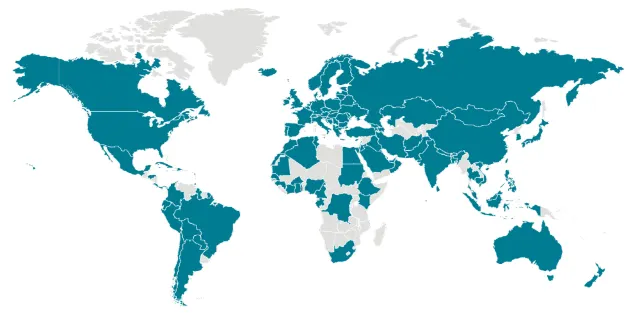Everything Travellers Need to Know About the Coronavirus (COVID-19)
Catalogue
- What We Know So Far
- Combating COVID-19
- What can you do to protect yourself on the trip?
- Current travel restrictions are included below.
- Australia
- New Zealand
- U.S.
- Canada
- Japan
Show More
In late December, 2019, reports emerged about a novel coronavirus circulating in Wuhan, China. The virus, officially known as SARS-CoV-2, is responsible for causing an infectious disease known as COVID-19. Since that time, travelers have been shocked by the speed and extent of the outbreak. Cases are continuing to rise outside of China as more countries identify infected persons within their borders. The situation on the ground is developing rapidly. We have put together this short explainer covering the current scientific consensus regarding the virus, efforts to combat the outbreak, and things travellers can do to keep themselves safe.
SARS-CoV-2 is part of a family of coronaviruses responsible for illnesses ranging from the common cold to more severe infections such as Middle East Respiratory Syndrome (MERS-CoV) and Severe Acute Respiratory Syndrome (SARS-CoV). The new SARS-CoV-2 strain was first detected in Wuhan, in Central China’s Hubei Province in early December, 2019. It had not previously been found circulating among humans.
To understand the impact SARS-CoV-2 is likely to have, it is instructive to consider two factors: the virus’ ability to spread and its lethality. Epidemiologists measure a virus’ spread using a basic reproduction number, which they refer to as R0 (pronounced: R-nought). The higher the value, the more quickly a virus is able to spread through a susceptible population. Current estimates place the R0 for SARS-CoV-2 around 2.4, meaning on average each infected person will pass the virus to between 2 to 3 new people. For context, HIV has an R0 of roughly 4 while the measles has an R0 of 18. Vaccination and prevention help to limit contagion. To date, however, there is no effective vaccine against SARS-CoV-2.
Lethality is simply the ratio of deaths to total number of infections. Current estimates suggest COVID-19 is lethal in roughly 2.4% of patients. Of these the elderly and those with preexisting health conditions are most at risk. For context, SARS-CoV was lethal in approximately 10% of patients while previous Ebola outbreaks resulted in 9 deaths for every 10 infections. Keep in mind, lethality must be considered within the scope of an outbreak. Influenza has an average lethality of only 0.2% yet it can kill upwards of 500,000 people each year.
COVID-19 is understood to have an incubation period extending up to 14 days. This means a person can go 14 days from the time they contract the virus to the first sign of symptoms. Critically, researchers have shown transmission can occur during the incubation period. In other words, people who do not know they are infected and who do not display outward symptoms such as fever or cough may be passing on the virus nonetheless.
Initially concentrated in mainland China with Hubei Province bearing the brunt of the outbreak, cases of COVID-19 have begun spreading on multiple continents. Beyond China, Iran and South Korea appear to be the most impacted. A significant cluster was identified in Northern Italy and the United States is now reporting it anticipates widespread transmission to occur over the coming weeks. Despite thus far refraining from officially designating COVID-19 a global pandemic, the WHO is urging countries to shift from a strategy of prevention to a strategy of containment.
Authorities in mainland China have implemented extraordinary measures to combat the outbreak. These include mandatory quarantining of entire cities and provinces. Schools and universities have been canceled and national holidays extended in an effort to reduce person-to-person contact. Confirmed cases exist in every Chinese province including the Hong Kong and Macau Special Administrative Regions. Far and away however, Hubei Province is most impacted with upwards of 67,000 confirmed cases at the time this was written. For that reason, travelers should avoid all non-essential travel to Hubei.
Internationally a number of countries including the United States, Japan, India, South Korea, and Australia have enacted partial travel bans covering persons who have visited mainland China or Hubei Province within the previous 14 days. The European Union is expected to follow suit. These nations have strongly advised their citizens and residents against traveling to mainland China or Hubei Province for the time being. A number of global airlines have cancelled flights to mainland China altogether or severely reduced their frequency. Additional travel restrictions will depend on how successful are current efforts at controlling the outbreak.
SARS-CoV-2 tends to spread via respiratory droplets expelled from an infected person through coughs or sneezing. As noted however, someone carrying the virus may not show outward symptoms and still be able to infect others. There are several things you can do to protect yourself. These include:
1. Regularly wash your hands with an antibacterial hand soap and use an alcohol-based hand sanitizer.
2. Avoid touching your face, especially your nose and mouth.
3. In areas where the virus is known to be spreading, avoid close contact with people and try to maintain a safe distance of at least one meter.
4. Cover your mouth and nose if you need to cough or sneeze.
5. Regularly disinfect your cell phone, keys, glasses, watch, and other personal items using an antibacterial cleanser or a solution of water and bleach.
6. Regularly disinfect surfaces in your home using an antibacterial cleanser or a solution of water and bleach.
7. In areas where the virus is known to be spreading, wear a surgical mask covering your mouth and nose when going out in public. Avoid touching other people (including shaking hands).
Staying vigilant and practicing these simple precautions will dramatically reduce the likelihood you contract COVID-19. Equally important is to remember that current media coverage tends to sensationalize events, often highlighting the most sensationalist stories or events. Keep your wits about you and consult expert information from the WHO or your country’s infectious disease specialists. COVID-19 is spreading and the risk remains high. However, there is no reason to panic and the best advice is to begin following the sensible precautionary measures outlined above.
Countries with confirmed cases of COVID-19 (Update 16th March)

Although WHO has advised against the far-reaching travel bans, many countries have take actions to avoid the domestic outbreak of coronavirus.
Our latest reference on countries/regions entry restrictions, subject to update, is available at:
From March 20, 2020, 21:00 AEDT, foreign nationals are prohibited from entering Australia. This policy does not apply to Australian citizens, residents, and their immediate family members.
From March 28, 2020, 23:59 AEDT, all persons arriving in Australia will be required to undergo a 14 day quarantine in a designated facility at their port of arrival.
From March 19, 2020, foreign nationals are prohibited from entering New Zealand. This policy allows for exemptions made on a case-by-case basis for humanitarian reasons, healthcare and other essential workers, citizens of Samoa and Tonga traveling to New Zealand for essential reasons, and partners or dependents of temporary workers or foreign students currently in New Zealand.
From April 9, 2020, all persons arriving in New Zealand must undergo quarantine at a designated facility.
From April 2, 2020, foreign nationals currently in New Zealand will be allowed to travel domestically in order to reach international airports in Christchurch or Auckland for outbound travel.
Foreign nationals who have visited any of the following countries / regions within 14 days of their arrival in the United States are prohibited from entering:
Austria, Belgium, China, Czechia, Denmark, Estonia, Finland, France, Germany, Greece, Hungary, Iceland, Iran, Ireland, Italy, Latvia, Liechtenstein, Lithuania, Luxembourg, Malta, Monaco, Netherlands, Norway, Poland, Portugal, San Marino, Slovakia, Slovenia, Spain, Sweden, Switzerland, Vatican City, United Kingdom.
American nationals and lawful permanent residents (including their family members) who have traveled in any of the above-listed countries / regions within 14 days of their arrival in the United States may enter; however, they will be redirected to one of 13 specially designated airports.
All persons returning to the United States should self-isolate and monitor their health for 14 days.
From March 20, 2020, the United States government has suspended the issuing of new visas.
From March 21, 2020, the United States’ land borders with Mexico and Canada are closed to all non-essential travel.
From March 16, 2020, foreign nationals are prohibited from entering Canada. This policy does not apply to permanent residents, US citizens, air crews, diplomats, and immediate family members of Canadian citizens.
From March 21, 2020, Canada’s land border with the United States is closed to all non-essential travel.
- Entry restrictions
From April 3, 2020, foreign nationals categorized below are denied permission to enter Japan.
(1) Foreigners who have stayed in any of the following countries/cities/provinces/regions within 14 days prior to the application for landing:
Asia: Brunei, Mainland China, Hong Kong SAR, Macau SAR, Indonesia, Republic of Korea, Malaysia, Philippines, Singapore, Taiwan, Thailand, Viet Nam
Oceania: Australia, New Zealand
North America: Canada, United States of America
Latin America and the Caribbean: Bolivia, Brazil, Chile, Ecuador, Dominica, Panama
Europe: Albania, Andorra, Armenia. Austria, Belgium, Bosnia and Herzegovina, Bulgaria, Croatia, Cyprus, Czech Republic, Denmark, Estonia, Finland, France, Germany, Greece, Hungary, Iceland, Ireland, Italy, Kosovo, Latvia, Liechtenstein, Lithuania, Luxembourg, Malta, Moldova, Monaco, Montenegro, Netherlands, North Macedonia, Norway, Poland, Portugal, Romania, San Marino, Serbia, Slovakia, Slovenia, Spain, Sweden, Switzerland, the United Kingdom, Vatican
Middle East: Bahrain, Israel, Iran,Turkey
Africa: Cote d’lvoire, Democratic Republic of Congo, Egypt, Mauritius, Morocco
(2) Foreigners who have Chinese passports issued in Hubei Province or Zhejiang Province of China.
(3) Foreigners who were on the cruise ship Westerdam, departed from Hong Kong.
- Quarantine requirements
(1) All nationals arriving from the countries and regions listed in paragraph 1 above within 14 days prior to their application for landing into Japan are subject to conduct PCR tests.
(2) All nationals arriving from all regions are called upon to wait 14 days at a location designated by the quarantine station chief and to refrain from using public transportation.
- Visa restrictions
Single and multiple-entry visas issued before 8 March 2020 by Japanese Embassies to China nationals (including Hong Kong and Macao SAR) have been suspended. For the full list of visa suspensions and the affected countries/regions, please refer to the website of the Ministry of Foreign Affairs of Japan.
Visa exemption measures have been suspended for a number of countries/regions, including Hong Kong SAR and Macao SAR. For the full list, please refer to the website of the Ministry of Foreign Affairs of Japan.
The above information is for reference only. The most up to date entry policies can be found in the respective country/region's official travel prohibitions, warnings, announcements, and advisories. This page will be kept up-to-date, but we urge all travelers to confirm travel restrictions with the relevant authorities.
Trending Travelogues
Popular Trip Moments
Popular Travel Types
Popular Attractions
Popular Ranked Lists
Popular Destinations
Recommended Attractions at Popular Destinations










Site Operator: Trip.com Travel Singapore Pte. Ltd.





